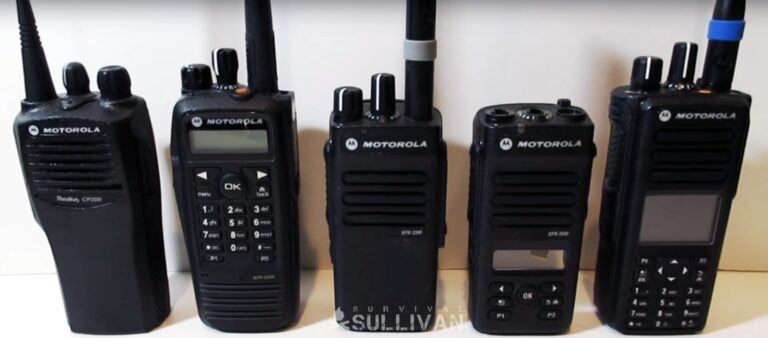One of the smartest things any prepper can do is invest in a self-contained communications technology. Cell phones are great, and the internet certainly changed the world, but you can’t exactly count on either of these in the aftermath of a major disaster or society-toppling event.

several Motorola walkie-talkies
Accordingly, most preppers are keen to invest in ham, GMRS, or FRS radio sets, but another one is being talked about lately that might be worth investigating: MURS. What exactly is MURS radio, anyway?
MURS stands for multi-use radio service, and it uses channels between 151 and 154 megahertz. Intended for short-range two-way communications with base stations or portable radios, it has long been used in industrial and business settings.
There are some folks who describe MURS as the best-kept secret in radio communication for civilians, and part of that is because it was once set aside for business use by the FCC, but only relatively recently in 2000 has it been opened up for public use.
It’s rarely discussed as a true competitor to GMRS, FRS, or even CB radio, but it has several legitimate aces up its sleeve you should know about. I’ll tell you about them in the rest of this article…
What’s MURS Used for Typically?
As said, MURS is intended for short-range, two-way communications, and for a long time, these frequencies were set aside for business and industrial usage. You might have heard of them referred to as the color dot frequencies before.
Interestingly, major corporations like Wal-Mart and others make constant use of MURS frequencies in their stores, warehouses, and other installations.
MURS Frequencies
MURS radio has five frequencies available for use:
- 151.820 MHz,
- 151.880 MHz,
- 151.940 MHz,
- 154.570 MHz,
- and 154.600 MHz.
What’s the Range Like on a MURS Radio?
It depends on a host of factors, but as a rule of thumb, you can get a range of 2 to 8 miles with a handheld MURS radio, certainly comparable and often superior to CB! Terrain, atmospherics, and other conditions as always will make a difference.
You can also get up to an impressive 20 miles with a MURS base station, meaning it might be a perfect choice for you if you’re only trying to keep in touch with folks in your immediate area.
Any Special Restrictions Associated with MURS Radio Use or Installation?
Yes. Transmitters are restricted to two watts of power and the height of your antenna, including the tower, cannot exceed 60 feet.
Licensing
No, happily it is not! MURS radio is license-exempt, meaning you don’t need to take a test or even pay to get a license in order to listen or transmit as long as you follow all the other relevant FCC rules.
Namely, for any emergency traffic being used on any of the five channels you’ve got to clear the airwaves and make way for it.
How Does MURS Compare with Other Radio Systems?
Most folks, including some serious radio enthusiasts, don’t know very much about MURS and how it stacks up to other, more common radio systems in use in the civilian sector.
For starters, MURS frequencies are far, far less crowded compared to CB, GMRS, and FRS.
They also transmit on the VHF band which gives them better coverage and range when outdoors compared to FRS radio. FRS, though, still works better in cluttered, urban environments.
A major consideration for potential MURS users is that they are not able to talk to GMRS and FRS radios, whereas those two systems can talk to each other.
Potentially a major advantage for large families or groups is the fact that MURS frequencies use private line codes which allow people to use the same channel, without hearing other users on that channel, as long as both parties are using the same code.
So even though MURS radio only has five frequencies, the 38 different codes mean you’ll have nearly 200 different possible combinations of channel and code. This will make it a lot easier to make a conversation harder to find or just prevent talking over each other in a group setting.
Lastly, MURS radios can make use of removable antennas, whereas FRS radios cannot. Considering how important the antenna is to your overall radio experience, being able to replace it or just switch it out for a better one might make the difference.
There are quite a few other differences besides, but those will have to wait for a more in-depth article!
Should You Get One?
If you’re thinking about getting a MURS radio as part of your emergency and disaster preparations, you can make a great case for it if you’re going to be in an outdoor area with a decent line of sight and a few obstacles.
It works especially well and has impressive range considering that it doesn’t require a license for use.
If used in a mobile capacity it provides superior range for vehicle-to-vehicle comms compared to FRS or GMRS in most settings, though the greater power available to GMRS radios might make a difference in truly wide-open spaces.
GMRS can also make use of repeaters to greatly extend range; sadly, the FCC has mandated that MURS radios cannot use repeaters for any reason.
Compared to the old standby of CB radio, CB looks better on paper because of greater power but CB radio frequencies are always, invariably clogged, and highly vulnerable to skip interference at extended distances.
That’s it, CB signals tend to go around or over obstacles better than MURS frequencies, don’t whether this will actually be an asset depends entirely on what you are doing with your radio.
All in all, MURS is certainly a suitable choice for close-range communications in a group setting, and made all the more attractive because of its plug-and-play nature and privacy code system.

The post A Primer on MURS Radio appeared first on Survival Sullivan.
https://www.survivalsullivan.com/murs-radio/
 CampingSurvivalistHuntingFishingExploringHikingPrivacy PolicyTerms And Conditions
CampingSurvivalistHuntingFishingExploringHikingPrivacy PolicyTerms And Conditions
